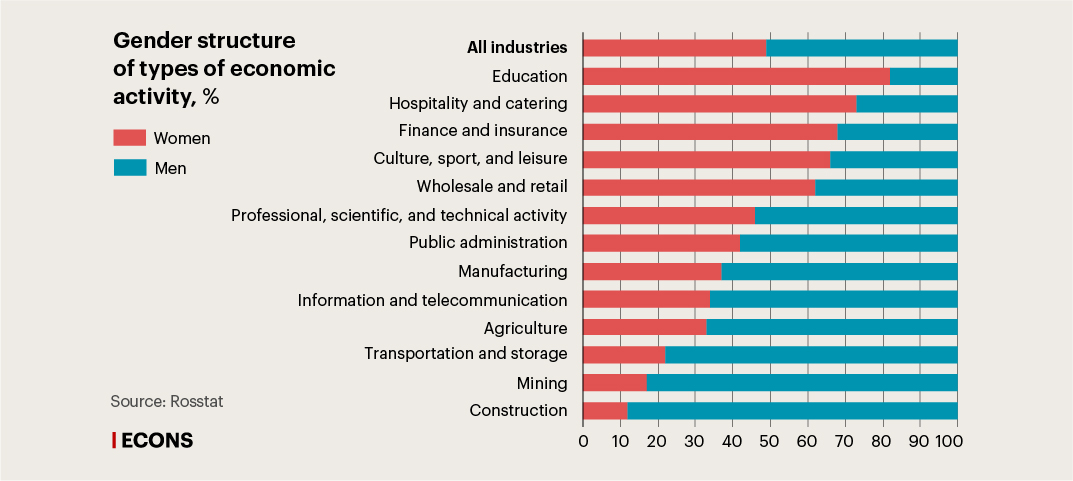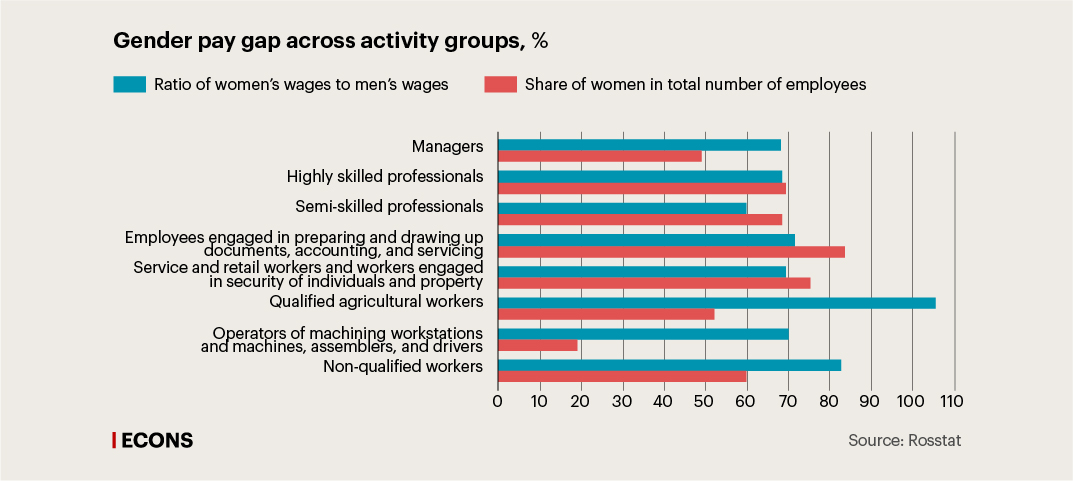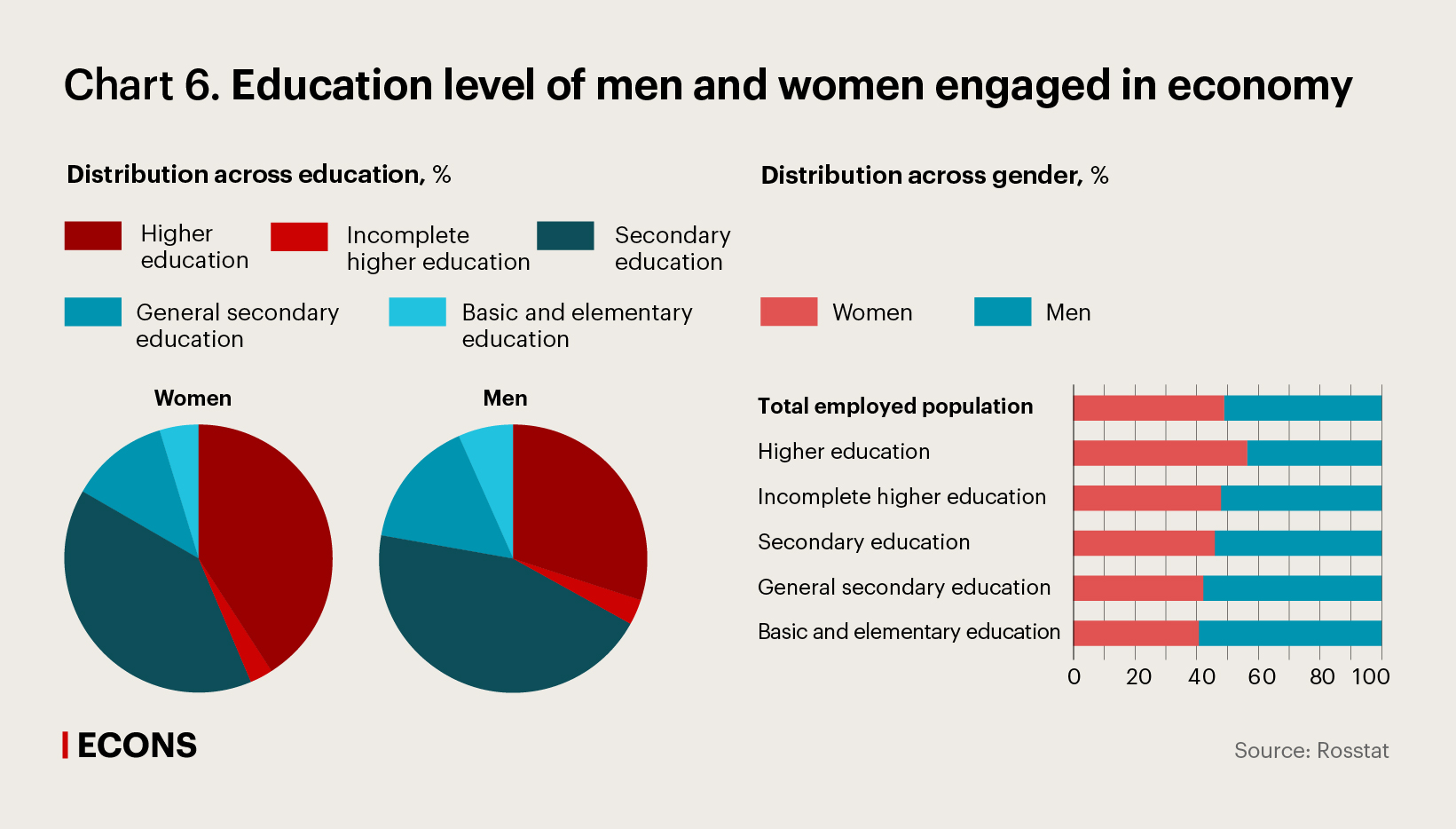Russia is somewhere in the middle of the Global Gender Gap Index, occupying the 81st place among 156 countries. In several subsections of the index, which is calculated by the World Economic Forum, Russia occupies high positions (the latest data concerning Russia are contained in the index for 2021). For example, in terms of economic participation, Russia is ahead of the USA and Western Europe due to the high female labour force participation rate, especially among professional and technical workers. In terms of the education and health subindices, Russia is in first place (along with 25 and 28 countries, respectively, with the highest enrolment of women in education and the longest healthy life expectancy among women). However, the gender gap in income and representation in politics remains vast (87th and 133rd places, respectively).
Why does Russia display such a contradictory level of gender inequality? Why don’t the high employment and education levels of women reduce the gender pay gap?
We have tried to answer this question by carrying out a comprehensive study based on axial institutions and agency. ‘Axial’ institutions are the institutions that play the most significant role in people's lives and determine their identities. They include the institutions of family and the labour market, education and science, as well as corporate governance and public administration.
Axial institutions present an axis that forms a person’s ‘agency’. The term was introduced into economic studies by Nobel laureate Amartya Sen in the consideration of various indicators (the level of health, education, etc.) which affect a person’s opportunities. Sen defines agency as an agent’s ability to choose a goal, the tools to achieve it and the ability to achieve the goal. That is, agency is defined as the agent’s ability to make decisions independently and form long-term rational plans. The collective aspect of the agency is important in the context of our study, specifically the agency of the largest social groups: women and men.
It is interesting that an agent may exercise different agencies in different institutions. Therefore, studying the agency in one institution, such as the employment market, may lead to erroneous conclusions. For example, an agent who has a successful career and high agency in the labour markets may have weak agency in the family institution and not dispose of his or her own income. The higher the agency, the more opportunities and authority the agent has, and vice versa, the lower the agency, the less freedom of choice the agent has.
Institutions of family and labour market
Gender economic studies (link in Russian) and global gender indices are primarily devoted to inequality in the labour market and especially to gender pay gaps (link in Russian). Comparing the activity, performance in the workplace, education, experience, and personal qualities of women and men, researchers conclude (1, 2, 3) that the level of gender inequality is mainly determined by gender stereotypes.
But where do these gender stereotypes come from? The basic institution forming the idea of gender roles is, of course, the family. In classic economic analysis, the family was perceived as a unified whole, as if all the family members agreed on everything and pursued similar goals. With the development of gender studies, it has become clear that this is not entirely the case. The application of game theory to households confirms that women’s bargaining positions are usually weaker than men’s, and therefore, women usually yield to their husbands.
The strong and weak bargaining positions of spouses are most pronounced when it comes to unpaid housework, which is predominantly a female responsibility worldwide. Gender economic studies apply negotiation theory, in which the power of agreements is treated as an important component in the gender distribution of the power and resources in a family.
In the average Russian family with children, both spouses work. The woman spends an average of 5.6 hours on work and almost 6 hours on housework and childcare on week days, while the man spends 9.1 and 1.5 hours, respectively. As a result, women work more than men, but over half of their work is uncompensated.
This ‘double burden effect’ is well-studied (link in Russian) in modern science, and the gap in participation in housework correlates highly with the pay gap (link in Russian) and with the levels of poverty and inequality. The more women work for free (at home), the more their paid work is devalued, since the employer considers a woman’s paid employment to be secondary and the woman herself as not a very reliable employee.



Men participate in childcare in modern Russian society. On weekends, the fathers in a third of Russian households spend (link in Russian) no less (or even more) time with the children than the mothers. Generally, women in Russia spend 2.2 times more time per day on household chores than men. Compared with the entire world, this is much closer to the leading countries (it is 25% more time in Sweden) than to the end of the list (10 times more in Mali and Pakistan).
The gender gap in paid employment, i.e. the ratio of officially employed women and men in Russia is not large either (78%, see Chart 2). Among women aged 25–59, the labour force participation rate, i.e. the share of employed women and women seeking employment is (link in Russian) 68–93% (depending on the age group), compared to 85–96% among men of the same age range; this includes 85% participation among women with children under 18. Men and women actually account for equal shares of all employed Russians, 51% and 49%, respectively.



However, the next important axial institution in Russia – the labour market – is highly gender-specific: most industries are characterised either as ‘female-dominated’ (i.e. women account for the majority of workers) or as ‘male-dominated’.



The female-dominated sectors (education and healthcare) are characterised by low salaries and the most insignificant gender salary gap (5–20%). The male-dominated sectors (manufacturing and IT), on the contrary, are characterised by the highest salaries and the largest gender pay gap (35–40%).



Education and science
In terms of the professional structure, women account (link in Russian) for 60% of highly skilled and semi-skilled professionals in Russia. This is a consequence of high levels of education: 41% of working women have higher education (compared with 30% of men).
Nevertheless, the level of higher education does not lessen the pay gaps (link in Russian), which vary from 5% to 40% depending on the area of activity and which substantially increase during crises. This is mainly due to limited opportunities for girls and women in the educational system, which is a result of the characterised of housework over productive labour (‘for a girls, the main thing is to give birth’; housekeeping classes teaching girls rather than boys to cook) and other gender stereotypes (link in Russian) maintained by the institutions of family and education.
Gender stereotypes result in pronounced segregation in terms of training (link in Russian) and, consequently, similar segregation in terms of professions and spheres of employment.






As a result, in terms of ‘candidates of sciences’ working in science, women are behind men to an insignificant extent and account for 43%, while in terms of ‘doctors of sciences’, women account for less than a third (28%). Women are even more scarcely represented in science management (they account for only 6% of the Presidium of the Russian Academy of Sciences and for 11.8% of rectors of Russian universities).
Governance institutions
Gender diversity in management impacts the efficiency of both public administration and corporate governance. It is crucial for representing various individual preferences and needs as well as for teams to work efficiently. Women’s representation is of particular importance. Groups with 20–40% of women outperform groups consisting entirely of men and groups with smaller proportions of women. This is why many countries, not only Western countries ( Norway, France, Italy, Germany, etc.) but also China, Armenia, Bangladesh, South Korea, Kyrgyzstan, Pakistan, etc., have introduced 20–40% gender quotas for management bodies.
The share of women on corporate boards of directors and in the management of government authorities demonstrates that governance remains a purely male-dominated activity in Russia, although the proportion of women is growing. According to the World Bank’s calculations, women accounted for 10% of the composition of the State Duma in 1997 and for 16% in 2023; in the cabinet of ministers, they accounted for 0% in 2005 and for 5% in 2022. The progress is more pronounced in the corporate segment, with 14.7% of firms including women in their senior management in 2009 and 24% in 2019.
Agency: measurement and assessment methods in Russia
Agency may be measured as the ability to make independent decisions at the individual, family and community levels. One method to measure this is Rotter’s locus of control. It divides people into those prone to explain what is happening by external factors and those inclined to explain current developments by their own behaviour.
The economic locus of control evaluates the extent to which the agent associates his or her economic well-being with internal or external factors. Studies show that Russian women demonstrate external locus of control and the need ‘to be a part’ more frequently, whereas men demonstrate internal locus of control more frequently. However, this gender delineation of internal and external locus of control does not show what exactly determines its direction.
A valuable source of data for agency analysis is the World Values Survey (WVS). It includes a self-assessment of the level of freedom and control over one’s own life, which is used as an indirect indicator for measuring agency and the factors determining it.
Russian women’s subjective agency assessment averages 6.3 out of 10, which puts Russia in the 8th place from the bottom among 103 countries and which is substantially lower than is the case for Russian men (7.0) and lower than the world average (7.1 as reported by women and 7.2 by men). This large gender gap is a specific feature of Russia.
Such a low self-assessment of agency is not in line with one of the world’s highest levels of education, the high employment rate of Russian women according to global standards, and almost the highest share of women who are main breadwinners as compared with the rest of the world (51% vs 26% worldwide). Only Finland displays a higher indicator (53%).
This can be explained, among other things, by the fact that characterise work over family in general is less typical of Russian women than of men (54% and 63%, respectively). When an agent considers his or her job to be an important part of his or her life, this increases agency not only due to higher income and human capital, but also due to the realisation of potential and the achievement of ambitions. Prioritising family, on the contrary, requires the sacrifice of human capital and the dedication of time to children, the spouse, and the elderly family members.
Women are the main contributors of time and care in the family institution, while men are recipients. Therefore, according to (link in Russian) our WVS analysis, characterise family and marriage in general adversely affects women’s agency. Prioritising work, on the contrary, has the most positive effect on it. Women who have working husbands also win in terms of agency, whereas men lose.
A general conclusion can be drawn that the subjective assessment of the development of Russian women’s agency is not identical to the assessment of the formal expansion of their rights and opportunities. This is confirmed by the common gender stereotypes in the family, employment, and management institutions.
We can say that gender equality in Russia is characterised by an incomplete transition to egalitarian institutions: on the one hand, women are actively involved in paid employment, and on the other hand, they are the main contributors of care and are scarcely represented in management in the public, corporate, and scientific segments.
Gender balance
Gender equality has two basic and related macro dimensions: demographic and economic.
First, gender discrimination against women adversely affects not only women, but also men. Russian men’s super-short life expectancy is a result of gender inequality (the life expectancy of those born between 1995 and 2005 is 58–59 years for men vs 71.5–72 years for women, .xlsx; (file in Russian) in 2024, (link in Russian) it is 64 and 75.5, respectively). Gender discrimination against women adversely affects men’s life expectancy due to several factors. The attitude treating men as the principal earners in the family results in high levels of stress among men, masculine stereotypes assume that taking care of one’s own health and visiting doctors is a sign of weakness, and men’s weak involvement in household activities and childcare results in antisocial behaviour.
Second, gender equality is a fundamental of economic growth. If human gender rather than capabilities becomes a determinant, the quality of human capital drops and labour resources are inefficiently distributed.
Modern post-industrial societies are characterised by declining birth and death rates, which results in the reduction and aging of the population. However, the latest studies confirm that the birth rate increases ( 1, 2, 3) when gender equality increases and the burden of housework and childcare is more equally distributed between men and women.
The expansion of the rights and opportunities of fatherhood is the most efficient and underestimated resource of economic and demographic potential. The involvement of men in household activities reduces the level of divorce and increases the likelihood of multi-child families, thus stimulating the birth rate. Involved fatherhood also promotes an increase in men’s life expectancy (link in Russian), since fathers are more inclined to choose healthier behaviour patterns.







